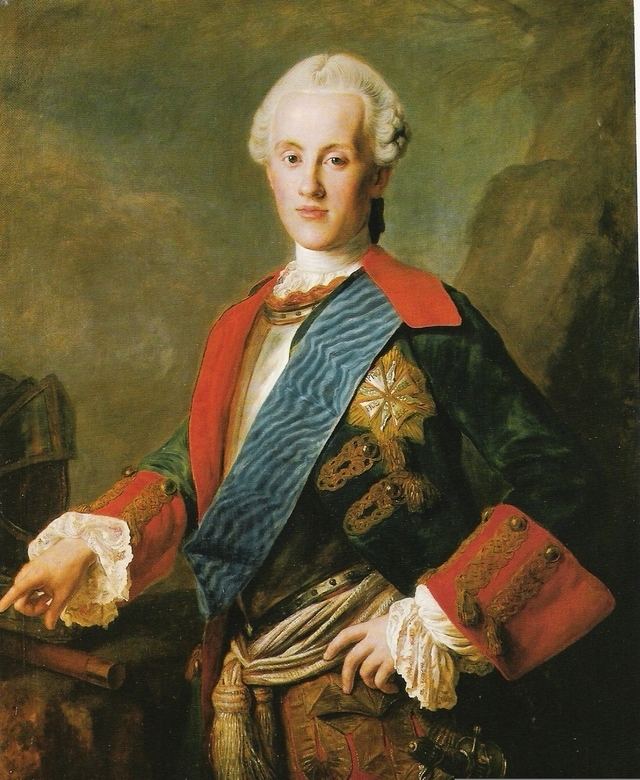Reign 1758–1763 Role Prince Name Charles Saxony, | House House of Wettin Successor Ernst Johann von Biron Siblings Maria Amalia of Saxony | |
 | ||
Predecessor Louis Ernest of Brunswick-Luneburg Born 13 July 1733
Dresden ( 1733-07-13 ) Burial Marienstern Monastery, Muhlberg. Issue Maria Christina, Princess of Carignan Died June 16, 1796, Dresden, Germany Spouse Franciszka Corvin-Krasinska Children Princess Maria Christina of Saxony Parents Augustus III of Poland, Maria Josepha of Austria Similar People Augustus III of Poland, Prince Francis Xavier of, Maria Josepha of Austria, Maria Amalia of Saxony, Maria Josepha of Saxony | ||
Prince Karl Christian Joseph of Saxony (13 July 1733 – 16 June 1796) was a German prince of the House of Wettin and a Duke of Courland and Semigallia. Born in Dresden, he was the fifth but third-surviving son of Augustus III, King of Poland and Elector of Saxony, and Maria Josepha of Austria.
Contents
- Causes of his election as Duke of Courland
- Duke of Courland and Semigallia
- Renunciation of the Duchy and later life
- Morganatic marriage and issue
- References
Causes of his election as Duke of Courland
The Duke of Courland and guardian of the Russian Tsar Ivan VI, Ernst Johann von Biron — hated by the Russian aristocracy because of his extravagances and autocratic government — was removed from the regency upon the agreement of the Tsar's mother, Anna Leopoldovna, in 1740 and arrested. The attempts of Anna Leopoldovna in making herself a popular regent failed and her Prime Minister Burkhard Christoph von Munnich —who had organized the conspiracy against Biron— was dismissed because of political and personal differences between both. Afterwards, a plot surrounding the Grand Duchess Elisabeth Petrovna against the regent was a complete success. In 1741, Anna Leopoldovna, her son Ivan and the rest of their family were exiled to Riga.
Now, certainly, the Tsarina Elisabeth gave her pardon to Biron. However, because of fear that he could again return to great power such as he had obtained during his old reign, she refused to restore to him his old dignities and the Duchy of Courland. To occupy the new headship of the Duchy, the local knighthood —under pressure from Saxony and Poland— chose the favorite son of the Polish king, Prince Karl Christian, in 1758 as their new Duke. The young prince had previously travelled to St. Petersburg, from which came the agreement of Tsarina Elisabeth, confirming these plans from their part.
Duke of Courland and Semigallia
Most of Evangelic Courland aristocracy had big doubts about Karl —largely because they feared a Roman Catholic Duke would drive back his influence in favor of the Polish-Roman Catholic State— and tried to limit Karl’s means by a contract formulated electoral surrender. Before these negotiations could come to their conclusion, his father appointed him as Duke on 10 November 1758 and formally invested him on 8 January 1759 with the Duchy of Courland and Semigallia. Thereupon Karl, who had signed only a very much generally regarded assurance to religious questions and aristocratic privileges, traveled to Courland and, on 29 March 1759, he solemnly entered the capital of his duchy, Mitau. After the Courland Diet (Landtag) and the States had met, they lost their hope of wringing a statement from Karl. Nevertheless, they still favored him. Appropriately, many aristocrats refused to homage the duke’s appointment on 3 November 1759 and instead waged protest in Warsaw and St. Petersburg.
The Duke was fond of life and lived in a remarkably splendid household on the Schloss Mitau. He amused the aristocracy with parties and courtly hunts, with which he was able to increase his supporters. Also, he took over the guidance of the Freemason's medal, blossoming at that time in Poland, and protected himself so with a lot of aristocrats whom knights of an order were in agreement. He left domestic politics, however, in the hands of his Country Controller (Landhofmeister), Otto Christoph von der Howen.
Renunciation of the Duchy and later life
In July 1762, the Tsarina Catherine the Great —who had been unapproving of Duke Karl on the basis of his lacking interest in the mental education of his subjects— took the Russian throne after a coup d'état. She allowed the now entirely rehabilitated Biron to return from his exile and exercised a substantial diplomatic pressure on Saxony, with the purpose of restoring him to his old office as Duke. Finally, a sickly Augustus III —not only for his declined health but also by the consequences of the Seven Years' War— accepted the fate of his son and denied his support to him. Without any support, Karl had to renounce the Duchy in 1763, and he then returned to Saxony.
His hopes to win back the Duchy of Courland scattered after the quick death of his father and the loss of the Polish Crown for the Saxon Electors. Thereupon, Karl lived in Dresden and dedicated himself to the hunt in the Annaburger Heath.
Karl died in Dresden at age sixty-two. He was buried in the Marienstern Monastery (Kloster Marienstern) of Mühlberg.
Morganatic marriage and issue
In Warsaw on 21 March 1760, Karl secretly married Franciszka Corvin-Krasińska, daughter of Count Stanislaus Corvin-Krasiński. Because Franziska did not belong to a ruling dynasty or immediate noble family, the marriage was morganatic. In response to the persistence of Karl and the Saxon court, in June 1775 she received from Emperor Joseph II the title of Princess. The couple had two daughters:
- Maria Theresia (born and died 1767).
- Maria Christina Albertina Carolina (born Dresden, 7 December 1770 - died Paris, 24 November 1851), married firstly on 24 October 1797 to Carlo Emanuele of Savoy, Prince of Carignan, and after his death she was married on 1 February 1816 to Jules Maximilien Thibaut, Prince de Montléart.
Through his surviving daughter's first marriage, Karl is an ancestor of the later Kings of Italy.
